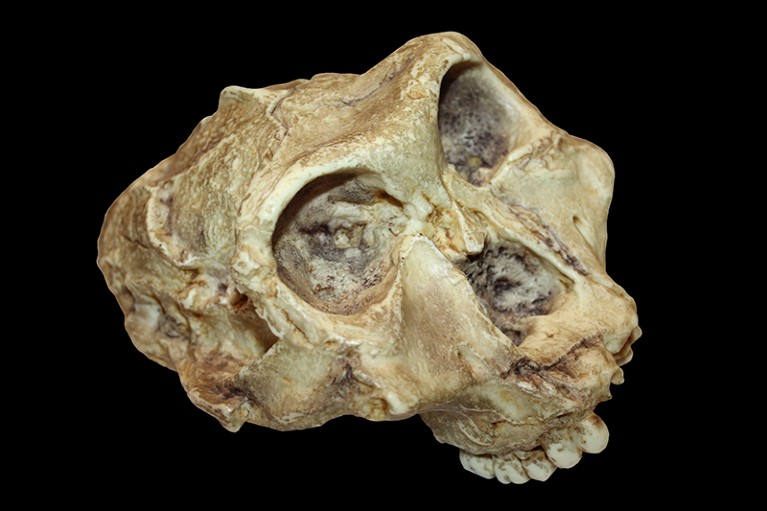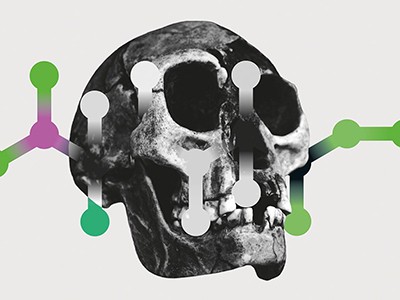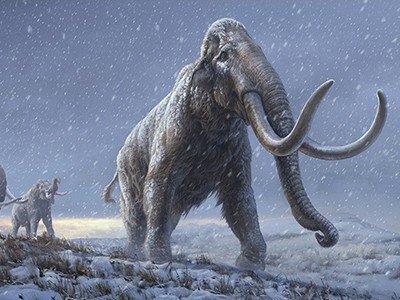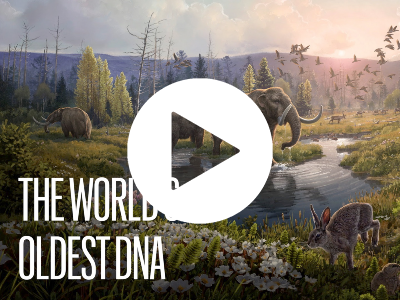Oldest genetic data from a human relative found in 2-million-year-old teeth

A Paranthropus robustus skull.Credit: Sabena Jane Blackbird/Alamy
Hominins — humans and their ancient relatives — emerged in Africa some seven million years ago. Now researchers have gleaned genetic information from an African hominin that lived two million years ago, the oldest such data yet recovered.
The protein sequences, described in a preprint posted on the bioRxiv server on 3 July1, come from several Paranthropus robustus tooth fossils found in a South African cave.
These genetic data are the oldest that have been collected from any hominin, pushing back the genetic record to times and places previously unthinkable, scientists say.
“It’s an amazing result,” says Katerina Douka, an archaeological scientist at the University of Vienna. At that age, the remains have “almost turned into stone”, she adds.
It is unclear whether the few sequences that can be recovered from very old fossils can help to untangle evolutionary relationships that scientists have debated over for decades. “Nobody really knows yet how useful this will be,” says Beatrice Demarchi, a biomolecular archaeologist at the University of Turin, Italy.
Preserved proteins
Last year, researchers obtained genetic sequences from two-million-year-old samples of Greenland permafrost2, setting the record for the oldest discovery of preserved ancient DNA. But DNA degrades quicker in warmer climates. Researchers went to heroic efforts to sequence a sliver of the oldest hominin DNA on record: a 400,000-year-old Neanderthal genome, which was found in an underground pit in Spain3.

Move over, DNA: ancient proteins are starting to reveal humanity’s history
Proteins tend to be more resilient than DNA, allowing researchers to push the molecular record further back in time. In 2016, Demarchi’s team obtained protein sequences from ostrich (Struthionidae) eggshells in Tanzania that were up to 3.8 million years old4.
Several years later, a team co-led by Enrico Cappellini, a protein chemist at the University of Copenhagen (KU), sequenced tooth proteins from roughly 800,000-year-old remains belonging to a species called Homo antecessor in Spain, as well as more limited sequences from 1.8-million-year-old Homo erectus fossils from Georgia5.
In the 2023 study, a team led by Cappellini and his colleagues at KU — protein scientist Claire Koenig, molecular biologist Ioannis Pastramanis and molecular biologist Palesa Madupe — sampled four P. robustus teeth from Swartkrans cave, 40 kilometres northwest of Johannesburg. Researchers have long debated how these stout-bodied hominins are related to other ancient human species.
The researchers used a technique called mass spectrometry to analyse hundreds of amino acids in each sample’s enamel, the mineral outer layer of teeth.

Million-year-old mammoth genomes shatter record for oldest ancient DNA
One protein they found, called amelogenin-Y, is produced by a gene on the Y chromosome. Its presence in two of the samples allowed the researchers to conclude that the teeth belonged to males. One of these had previously been attributed to a female on the basis of its small size. The other two teeth lacked signs of amelogenin-Y and contained the X-chromosome version of the protein, leading the authors to deduce that the specimens were probably from females.
Around 400 of the same amino acids were sequenced in all four samples. This allowed the researchers to build a simple evolutionary tree confirming that Homo sapiens, Neanderthals and hominins found in Siberia called Denisovans that lived in the past 200,000 years are all more closely related to one another than they are to the two-million-year-old Paranthropus. Any other relationship would have been a big surprise, says Douka.
In one enamel protein, the researchers found sequence differences between the Paranthropus remains, potentially reflecting variability within the species.
‘Potentially transformative’
Building an evolutionary tree from genetic data of such old remains “can be considered a potentially transformative breakthrough for palaeoanthropology”, Cappellini and his colleagues write in the preprint. They add that ancient-protein studies could improve understanding of where creatures such as Australopithecus afarensis — of which there are many fossil fragments and the more complete specimen known as Lucy — sit in the hominin family tree.
Other scientists say that the jury is still out on whether ancient proteins will help bring consensus to the picture of hominin evolution, which is currently built largely from the shapes of bones.

Record-breaking ancient DNA found in frozen soil
There is limited variability in enamel proteins, so the 425 amino acids Cappellini’s team used to construct the family tree seem less informative than the first Neanderthal sequences researchers sequenced in 1997; those included around 360 base pairs of mitochondrial DNA6, which carries lots of variation, notes Pontus Skoglund, a palaeogeneticist at the Francis Crick Institute in London. Bone shape is probably still a more reliable way than ancient proteins as a way to untangle relationships. “There is thus still a long way to go in evolutionary ancient proteomics.”
Demarchi agrees, but she’s also excited at the possibility of determining the sex of fragmentary fossils, particularly those of animals. It’s not uncommon for sex-based differences in size to be mistakenly attributed to species differences, and vice versa: P. robustus fossils were initially attributed to males of another, smaller southern African hominin.
As ancient proteomics expands, researchers say that it will also be key to balance the benefits against the costs of destructive sampling. Skoglund’s lab is working on non-destructive methods to screen fossils for their protein content — sparing samples that wouldn’t have yielded good data. “It is important that the ri
Related Post
A shocking documentary proves that mermaids do exist
SHOCKING Revelation: Thuya, Mother of Queen Tiye, Was the Grandmother of Akhenaten and Tutankhamun—What Ancient Egyptian Secrets Did She Leave Behind?
Breaking News: Astonishing Discoveries at Karahan Tepe Confirm an Extraterrestrial Civilization is Hiding on Earth, and NO ONE Knows!
Breaking News: Researchers FINALLY Discover U.S. Navy Flight 19 After 75 Years Lost in the Bermuda Triangle!
NASA’s Secret Investigation: Uncovering the Astonishing Mystery of the UFO Crash on the Mountain!
Explosive UFO Docs LEAKED: Startling Proof That Aliens Ruled Ancient Egypt!